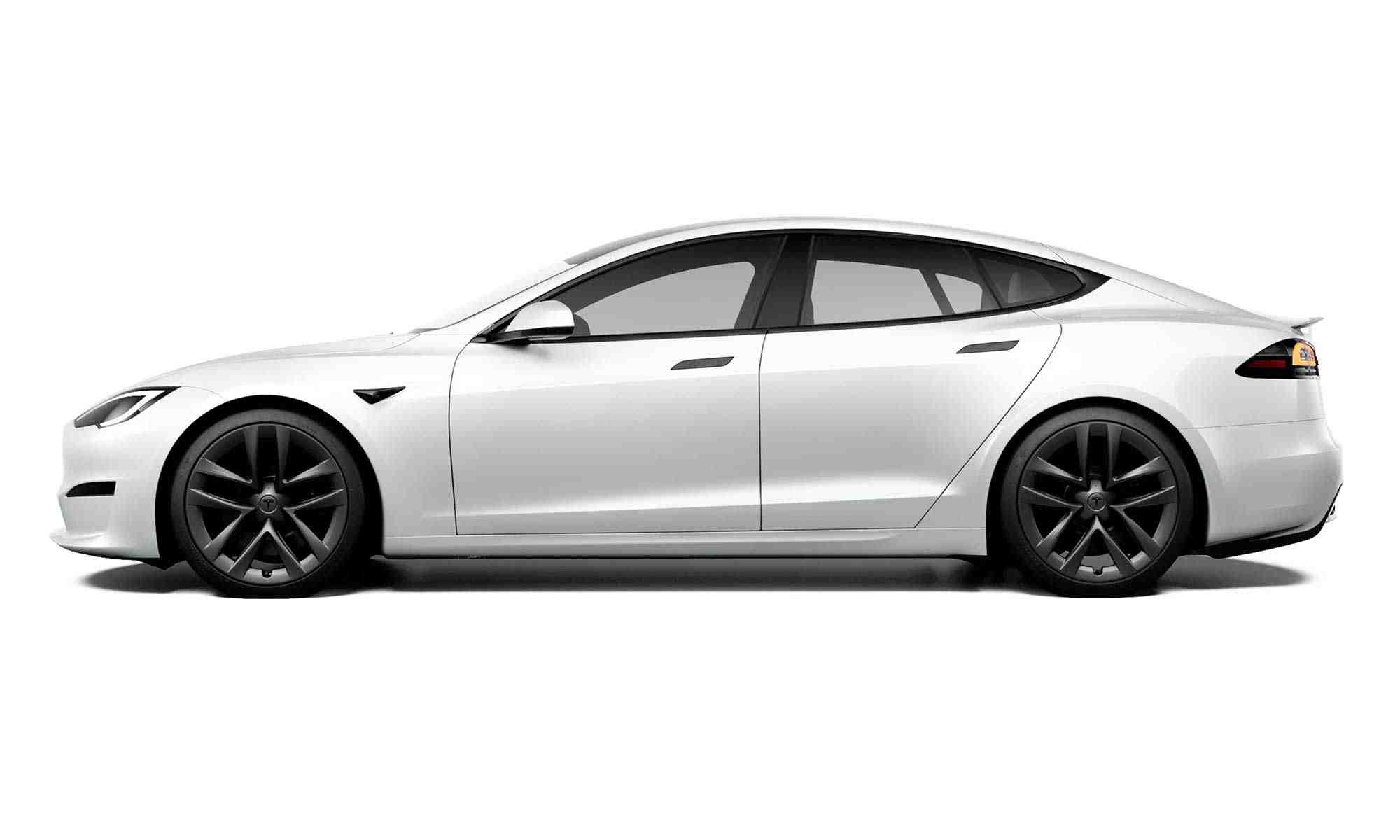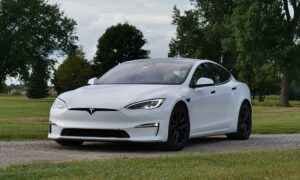Tesla Model S (2022)
The complete guide to the Tesla Model S vehicle range (2022), from the car itself to running costs and charging.
Last updated: Nov 13, 2024 • 9 min read

KEY STATS
Range (WLTP):
283 - 405 miles
Electric cost/mile:
7.73p - 8.29p
Rapid charge:
Yes
EV type:
Battery electric
Overview
When Tesla launched their phenomenal Model S back in 2013, it was the first mass-market all-electric car. Considered one of the finest (electric) cars ever made at the time, the Model S has come a long way since then, with new variants including the ludicrously fast Plaid (0-60mph in under 2 seconds anyone?) and the aptly-named Long Range (range anxiety? What’s that?). Whichever variant you pick, you’ll be sure to get big range and jaw-dropping performance. The below guide shows data ranges for the current Tesla Model S variants available, specs will depend on your selected configuration.
Charging Details
Charging time for a Tesla Model S
The table below shows the estimated time to charge your Model S from empty to full. For rapid charging, we show the time to charge from 20% - 80%, as charging tends to slow outside this range to protect the battery.
| Charging method | Typically found at | Charging time* | Range/hour** |
|---|---|---|---|
| Empty to full | |||
| 3-pin plug | Home | 33 - 44 h | 8 - 8 m/h |
| 3.6kW | Home / Work | 21 - 27 h | 12 - 13 m/h |
| 7kW | Home / Work / Public Locations | 11 - 15 h | 24 - 25 m/h |
| 22kW | Work / Public Locations | 5 - 6 h | 56 - 60 m/h |
| 20%-80% | |||
|---|---|---|---|
| 50kW | Public Locations | 60 - 80 min | 84 - 91 m/30 min |
| 150kW | Public Locations | 30 - 30 min | 169 - 272 m/30 min |
* Based on Pod Point estimates, charging time can differ based on the ambient temperature, the state of the battery (e.g. empty or half full) and variation in charging rate. Max charging rate may also be limited by the vehicle.
** Range per hour is the number of miles you can expect to get from an hour of charging at the relevant rate.
Connector type and charging rates
You can charge your Tesla Model S with a Type 2 connector at home, work or at a public charging point. There is also a CCS connector for rapid charging.

|

|
Where you can charge a Tesla Model S
You can charge your Tesla Model S conveniently at home, plug-in when you arrive at work or top up when you're out and about at locations including supermarkets and public car parks.
At Home7kW Solo Charger Find out more about Smart Home Charging |
At Work7kW Solo Charger* |
Built Environment Charging7kW Solo or Twin Charger |
On Public Networks7kW Solo Charger & Rapid Charging** |
* Other charging options are also available, speak to our team for more information.
** Available for vehicles with either CCS or CHAdeMO connectors.
Cost to charge
Cost of charging a Tesla Model S
The cost of charging your car will vary between home, work and public chargepoints (below are our estimates). Charging on the Pod Point Network can be accessed through the Pod Point App.
| Place | Avg. cost | Cost/mile |
|---|---|---|
| Home (empty to full)* | £19.95 - £26.60 | 7.73p - 8.29p |
| Public rapid chargers (20%-80%)** | £18.81 - £25.08 | 12.14p - 13.03p |
* Assumes tariff of 28p/kWh. The cost of home charging will vary depending on your electricity rate.
** Assumes tariff of 44p/kWh applicable to most network rapid chargers as of April 2022.

Vehicle Specs
Range
| Official range (WLTP*) | 283 - 405 miles |
| Pod Point Confidence Range** | 241 - 344 miles |
* For more information on "WLTP", "NEDC" and more, please visit our Electric Vehicle Dictionary.
** Pod Point Confidence Range is the maximum distance we’d be confident driving on electric power between charges. Real range will depend on various factors including driving conditions, personal driving style, outside temperature, heating / air conditioning, etc.
Performance
| 0-62 mph | 4.2 - 2.1 seconds |
| Top speed | 155 - 200 mph |
| Engine power | 534 - 1020 bhp / 398 - 772 kW |
| Torque | 755 - 755 Nm |
Battery
| Battery size | 75 - 100 kWh |
| Usable battery (Pod Point estimate) | 71 - 95 kWh |
| Official battery efficiency (WLTP) | 312 - 312 Wh/mile |
| Battery efficiency (Pod Point estimate) | 276 - 296 Wh/mile |
Environmental impact
| Official MPG (WLTP) | N/A |
| Official CO2 emissions (WLTP) | 0 gCO2/km |
| CO2 emissions from UK grid electricity usage (Pod Point calculated)* | 32 - 35 gCO2/km |
* This metric estimates the environmental impact of driving your electric vehicle based on how the electricity that powers your car is generated. We take the average carbon intensity across the UK grid measured throughout 2021 to calculate the expected grams of CO2 emitted per 1 km driven. The actual number will vary by region, when you charge (e.g. carbon intensity is usually lower overnight period) and whether your electricity comes from more renewable sources than the average.
Purchase, Tax & Grants
The Tesla Model S is only eligible for the Electric Vehicle Homecharge Scheme (EVHS) grant, but you will benefit from £0 year 1 road tax and £0 London Congestion Charge.
Purchase
| OTR price* | From £72,495 |
* On-the-road price including Plug-in Car Grant, if applicable.
Tax
| Vehicle Excise Duty (VED) | Amount |
|---|---|
| Year 1 | £0 |
| Years 2-5 | £0 |
| Benefit in Kind (BiK) tax year | BiK tax rate | Annual BiK value |
|---|---|---|
| For cars registered after 6 April 2020 | ||
| 22/23 | 2% | From £1450 |
| 23/24 | 2% | From £1450 |
| 24/25 | 2% | From £1450 |
* For further information including how to calculate personal BiK liabilities, please visit our Electric Car Tax guide.
| Local taxes | Amount |
|---|---|
| London Congestion Zone Charge* | £0 |
| Ultra Low Emission Zone Charge** | £0 |
* A £10 annual registration fee will still apply to each vehicle.
** For further information on London's Ultra Low Emission Zones (ULEZ), please visit our ULEZ guide.
| Insurance | |
|---|---|
| Insurance group | 50 |
Grants*
| Grant name | Eligibility | Amount | Benefit |
|---|---|---|---|
| OZEV EV chargepoint grant | ✔ | £350 | Can be used to reduce the cost of a home charger with installation |
| OZEV Plug-in Grant | ✘ | £0 | Used to reduce the cost of the vehicle |
| EST Domestic Charge Point Grant (currently unavailable) | ✔ | £300 | Can be used in Scotland in addition to the EV chargepoint grant to reduce the cost of a home charger with installation |
* Prices for vehicles are typically displayed with the Plug-in grant discount already applied. Home charging grants are dependent on status of the grant, and subject to eligibility requirements of the applicant as well as the vehicle.
Pros and cons of a Tesla Model S
There’s no denying - the Tesla Model S offers some of the best performance and specs on the market. If you’re willing to pay for the best Tesla has to offer, this car might just be for you.
Pros |
Cons |
|---|---|
| ✔ Rapid charge enabled | ✘ High insurance group rating |
| ✔ Above average range (WLTP) of up to 405 miles | ✘ More expensive than Tesla Model 3 |
| ✔ Cost per mile comparable with other saloon-style cars | ✘ Top range and speed available at extra cost only |
| ✔ Cheaper than Tesla Model S | |
| ✔ Top speed of up to 200 mph | |
| ✔ No road tax, London Congestion Charge or ULEZ charge | |
| Pod Point rating: | 4 out of 5 |
Want to see what else Tesla has to offer?
You want something similar to the Model S, but for less? Check out our Tesla Model 3 review for an alternative that gives you great performance and specs for a fraction of the price.
In our Tesla Model Y review, we give you the run-down on their entry-level SUV, giving you more space at a price you won’t expect.
Last but not least, the Model X. This is Tesla’s top range SUV, packed with impressive speed and range. Learn more about it in our Tesla Model X review.
